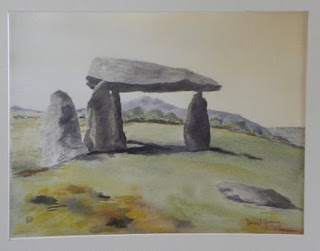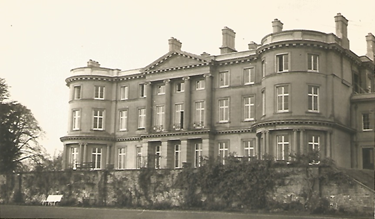Two Megalithic Burial Chambers
Megalithic Burial
Chambers
David Young the artist and a member of the MAA, has sent two
of his evocative water colours. David writes. ‘Here are two water colours of mine that I did some years ago,
based on photographs taken by me, of Pentre Ifan and Carreg Samson,
Neolithic burial chambers in Pembrokeshire. The weather was not like that shown
in the pictures. I remember deciding to make one peaceful and sunny and the
other ominous and stormy. I think the representation of the monuments was
fairly accurate, though not in the style that professional antiquarians would
choose. I was attending the Summer Meeting of the Cambrians in 1992, but I have
been to both sites since.’ He adds ‘Don't take the background hills in my
picture as authentic. I used artistic licence to bring them nearer.’
Carreg Samson Pembrokeshire
© David Young
Editor’s comments
Dating: Although
these two tombs are in Pembrokeshire they are important examples of Megalithic tombs also
known as cromlechs or dolmens which date to the Neolithic. Such tombs are found
from Spain to Scandinavia. It was only in 1836 that Danish curator Thomsen
noted that they were not found with metal tools. In 1863 the Secretary of the
Cambrian Archaeological Society, Edward Barnwell, noted that they must
therefore belong to the Stone Age. They
were constructed between 4000 BC until at least 3000 BC
Pentre Ifan is a classic
example of a portal dolmen and today all you can see is the massive capstone of
16 tons and three stones. Two stones flank the entrance or portal which is
sealed by a blocking stone. It would have been covered with a rectangular cairn
or mound. Finds included a small quantity of burnt bone, probably human,
pottery and flints. There would probably
have been a forecourt for rituals associated with the dead.
Carreg Samson, near
Abercastle close to Fishguard, was possibly a passage tomb but all evidence of
the passage which allowed entrance to the tomb is lost. With passage tombs the
chamber is usually in the centre of the mound with access from a passageway
through which people could walk or crawl depending on the height. Excavation in
1968, revealed four additional stone-holes, one having supported a further chamber
stone, the others indicated a possible passage leading off to the NW. As you
can see from the painting the sea is in the distance. Excavations uncovered a
pottery vessel holding the cremated ashes of several people. The dolmen is
composed of seven upright stones topped by a capstone over 4.5m long. The
capstone is actually balanced on just 3 of the 7 support stones.
In Momouthshire:
there are only 4 certain sites, Gwern y Cleppa, Heston Brake, Thornwell and Y
Gaer Llwyd. The first 3 are on knolls or hills with views over the Bristol
Channel and Y Gaer Llwyd is on higher ground with a possible sight line to the
Bristol Channel. They are part of the Cotswold Severn Group stretching from
Gower to the mouth of the Wye.
If you would like to write about one of these or have a
picture please send it to me.
Thanks to: David Young for his evocative water colours,
Sources used:
Sian Rees, A Guide to Ancient & Historic Wales, Dyfed, Cadw, First
Edition. (1992)
Steve Burrow The Tomb
Builders in Wales 4000-3000 BC, NMW, 2006.
Coflein. https://coflein.gov.uk/en/site/101450/details/pentre-ifan-chambered-tomb-near-nevern
and https://coflein.gov.uk/en/site/94129/details/carreg-sampson-burial-chamber
See also Rick Peterson and Joshua Pollard, ‘The Neolithic:
The First Farming Societies’ in The Gwent
County History, Volume 1, UWP 2004




